Fair Warning: this article contains plot spoilers for Monkey Island 2: LeChuck’s Revenge and The Curse of Monkey Island. No puzzle spoilers, however…
The ending of 1991’s Monkey Island 2: LeChuck’s Revenge seems as shockingly definitive in its finality as that of the infamous last episode of the classic television series St. Elsewhere. Just as the lovable wannabe pirate Guybrush Threepwood is about to finally dispatch his arch-nemesis, the zombie pirate LeChuck, the latter tears off his mask to reveal that he is in reality Guybrush’s older brother, looking a trifle peeved but hardly evil or undead. Guybrush, it seems, is just an ordinary suburban kid who has wandered away from his family to play make-believe inside a storage room at Big Whoop Amusement Park, LeChuck the family member who has been dispatched to find him. An irate janitor appears on the scene: “Hey, kids! You’re not supposed to be in here!” And so the brothers make their way out to rejoin their worried parents, and another set of Middle American lives goes on.
Or do they? If you sit through the entirety of the end credits, you will eventually see a short scene featuring the fetching and spirited Elaine, Guybrush’s stalwart ally and more equivocal love interest, looking rather confused back in the good old piratey Caribbean. ‘I wonder what’s keeping Guybrush?” she muses. “I hope LeChuck hasn’t cast some horrible SPELL over him or anything.” Clearly, someone at LucasArts anticipated that a day might just come when they would want to make a third game.
Nevertheless, for a long time, LucasArts really did seem disposed to let the shocking ending stand. Gilbert himself soon left the company to found Humongous Entertainment, where he would use the SCUMM graphic-adventure engine he had helped to invent to make educational games for youngsters, even as LucasArts would continue to evolve the same technology to make more adventure games of their own. None of them, however, was called Monkey Island for the next four years, not even after the first two games to bear that name became icons of their genre.
Still, it is a law of the games industry that sequels to hit games will out, sooner or later and one way or another. In late 1995, LucasArts’s management decided to make a third Monkey Island at last. Why they chose to do so at this particular juncture isn’t entirely clear. Perhaps they could already sense an incipient softening of the adventure market — a downturn that would become all too obvious over the next eighteen months or so — and wanted the security of such an established name as this one if they were to invest big bucks in another adventure project. Or perhaps they just thought they had waited long enough.
Whatever their reasoning in beginning the project, they chose for the gnarly task of succeeding Ron Gilbert an in-house artist and a programmer, a pair of good friends who had been employed at LucasArts for years and were itching to move into a design role. Larry Ahern had been hired to help draw Monkey Island 2 and had gone on to work on most of LucasArts’s adventure games since, while Jonathan Ackley had programmed large parts of Day of the Tentacle and The Dig. Knowing of their design aspirations, management came to them one day to ask if they’d like to become co-leads on a prospective Monkey Island 3. It was an extraordinary amount of faith to place in such unproven hands, but it would not prove to have been misplaced.
“We were too green to suggest anything else [than Monkey Island 3], especially an original concept,” admits Ahern, “and were too dumb to worry about all the responsibility of updating a classic game series.” He and Ackley brainstormed together in a room for two months, hashing out the shape of a game. After they emerged early in 1996 with their design bible for The Curse of Monkey Island in hand, production got underway in earnest.
At the end of Monkey Island 2, Ahern and Ackley announced, Guybrush had indeed been “hexed” by LeChuck into believing he was just a little boy in an amusement park. By the beginning of the third game, he would have snapped back to his senses, abandoning mundane hallucination again for a fantastical piratey reality.
A team that peaked at 50 people labored over The Curse of Monkey Island for eighteen months. That period was one of dramatic change in the industry, when phrases like “multimedia” and “interactive movie” were consigned to the kitschy past and first-person shooters and real-time strategies came to dominate the sales charts. Having committed to the project, LucasArts felt they had no choice but to stick with the old-school pixel art that had always marked their adventure games, even though it too was fast becoming passé in this newly 3D world. By way of compensation, this latest LucasArts pixel art was to be more luscious than anything that had come out of the studio before, taking advantage of a revamped SCUMM engine that ran at a resolution of 640 X 480 instead of 320 X 200.
The end result is, in the opinion of this critic at least, the loveliest single game in terms of pure visuals that LucasArts ever produced. Computer graphics and animation, at LucasArts and elsewhere, had advanced enormously between Monkey Island 2 and The Curse of Monkey Island. With 1993’s Day of the Tentacle and Sam and Max Hit the Road, LucasArts’s animators had begun producing work that could withstand comparison to that of role models like Chuck Jones and Don Bluth without being laughed out of the room. (Indeed, Jones reportedly tried to hire Larry Ahern and some of his colleagues away from LucasArts after seeing Day of the Tentacle.) The Curse of Monkey Island marked the fruition of that process, showing LucasArts to have become a world-class animation studio in its own right, one that could not just withstand but welcome comparison with any and all peers who worked with more traditional, linear forms of media. “We were looking at Disney feature animation as our quality bar,” says Ahern.
That said, the challenge of producing a game that still looked like Monkey Island despite all the new technical affordances should not be underestimated. The danger of the increased resolution was always that the finished results could veer into a sort of photo-realism, losing the ramshackle charm that had always been such a big part of Monkey Island‘s appeal. This LucasArts managed to avoid; in the words of The Animation World Network, a trade organization that was impressed enough by the project to come out and do a feature on it, Guybrush was drawn as “a pencil-necked beanpole with a flounce of eighteenth-century hair and a nose as vertical as the face of Half Dome.” The gangling frames and exaggerated movements of Guybrush and many of the other characters were inspired by Tim Burton’s The Nightmare Before Christmas. Yet the characters aren’t grotesques; The Curse of Monkey Island aims to be lovable, and it hits the mark. For this game is written as well as drawn in the spirit of the original Secret of Monkey Island, abandoning the jarring mean-spiritedness that dogs the second game in the series, a change in tone that has always left me a lot less positively disposed toward it than most people seem to be.
This was the first Monkey Island game to feature voice acting from the outset, as telling a testament as any to the technological gulf that lies between the second and third entries in the series. The performances are superb — especially Guybrush, who sounds exactly like I want him to, all gawky innocence and dogged determination. (His voice actor Dominic Armato would return for every single Monkey Island game that followed, as well as circling back to give Guybrush a voice in the remastered versions of the first two games. I, for one, wouldn’t have it any other way.)
The opening sees Guybrush adrift on the open ocean in, of all forms of conveyance, a floating bumper car, for reasons that aren’t initially clear beyond the thematic connection to that amusement park at the end of Monkey Island 2. He floats smack-dab into the middle of a sea battle between LeChuck and Elaine; the former is trying to abduct the latter to make her his bride, while the latter is doing her level best to maintain her single status. Stuff happens, LeChuck seems to get blown up, and Guybrush and Elaine wind up on Plunder Island, a retirement community for aging pirates that’s incidentally also inhabited by El Pollo Diablo, the giant demon chicken. (“He’s hatching a diabolical scheme”; “He’s establishing a new pecking order”; “He’s going to buck buck buck the system”; “He’s crossing the road to freedom”; etc.) Guybrush proposes to Elaine using a diamond ring he stole from the hold of LeChuck’s ship, only to find that there’s a voodoo curse laid on it. Elaine gets turned into a solid-gold statue (d’oh!), which Guybrush leaves standing on the beach while he tries to figure out what to do about the situation. Sure enough, some opportunistic pirates — is there any other kind? — sail away with it. (Double d’oh!) Guybrush is left to scour Plunder Island for a ship, a crew, and a map that will let him follow them to Blood Island, where there is conveniently supposed to be another diamond ring that can reverse the curse.
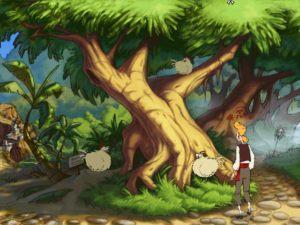
The vicious chickens of Plunder Island. “Larry and I thought we were so clever when we came up with the idea of having a tropical island covered with feral chickens,” says Jonathan Ackley. “Then I took a vacation to the Hawaiian island of Kauai. It seems that when Kauai was hit by Hurricane Iniki, it blew open all the chicken coops. Everywhere I went on the island I was surrounded by feral chickens.”
From the shopping list of quest items to the plinking steelband soundtrack that undergirds the proceedings, all of this is a dead ringer for The Secret of Monkey Island; this third game is certainly not interested in breaking any new ground in setting, story, or genre. But when it’s done this well, who cares? There is a vocal segment of Monkey Island fans who reject this game on principle, who say that any Monkey Island game without the name of Ron Gilbert first on its credits list is no Monkey Island game at all. For my own part, I tend to believe that, if we didn’t know that Gilbert didn’t work on this game, we’d have trouble detecting that fact from the finished product. It nails that mixture of whimsy, cleverness, and sweetness that has made The Secret of Monkey Island arguably the most beloved point-and-click adventure game of all time.
During the latter 1990s, when most computers games were still made by and for a fairly homogeneous cohort of young men, too much ludic humor tried to get by on transgression rather than wit; this was a time of in-groups punching — usually punching down — on out-groups. I’m happy to say that The Curse of Monkey Island‘s humor is nothing like that. At the very beginning, when Guybrush is floating in that bumper car, he scribbles in his journal about all the things he wishes he had. “If only I could have a small drink of freshwater, I might have the strength to sail on.” A bottle of water drifts past while Guybrush’s eyes are riveted to the page. “If I could reach land, I might find water and some food. Fruit maybe, something to fight off the scurvy and help me get my strength back. Maybe some bananas.” And a crate of bananas drifts by in the foreground. “Oh, why do I torture myself like this? I might as well wish for some chicken and a big mug of grog, for all the good it will do me.” Cue the clucking chicken perched on top of a barrel. Now, you might say that this isn’t exactly sophisticated humor, and you’d be right. But it’s an inclusive sort of joke that absolutely everyone is guaranteed to understand, from children to the elderly, whilst also being a gag that I defy anyone not to at least smirk at. Monkey Island is funny without ever being the slightest bit cruel — a combination that’s rarer in games of its era than it ought to be.
Which isn’t to say that this game is without in-jokes. They’re everywhere, and the things they reference are far from unexpected. Star Trek gets a shout-out in literally the first line of the script as Guybrush writes in his “captain’s log,” while, appropriately enough given the studio that made this game, whole chunks of dialogue are re-contextualized extracts from the Star Wars movies. The middle of the game is an extended riff on/parody of that other, very different franchise that springs to mind when gamers think about pirates — the one started by Sid Meier, that’s known as simply Pirates!. Here as there, you have to sail your ship around the Caribbean engaging in battles with other sea dogs. But instead of dueling the opposing captains with your trusty cutlass when you board their vessels, here you challenge them to a round of insult sword-fighting instead. (Pirate: “You’re the ugliest monster ever created!” Guybrush: “If you don’t count all the ones you’ve dated!”)
One of the game’s best gags is an interactive musical number you perform with your piratey crew, feeding them appropriate rhymes. “As far as I know, nobody had ever done interactive singing before,” says Jonathan Ackley. “I think it was an original idea and I still laugh when I see it.” Sadly, the song was cut from the game’s foreign localizations as a bridge too far from its native English, even for LucasArts’s superb translators.
It shouldn’t work, but somehow it does. In fact, this may just be my favorite section of the entire game. Partly it succeeds because it’s just so well done; the action-based minigame of ship-to-ship combat that precedes each round of insult sword-fighting is, in marked contrast to those in LucasArts’s previous adventure Full Throttle, very playable in its own right, being perfectly pitched in difficulty, fun without ever becoming frustrating. But another key to this section’s success is that you don’t have to know Pirates! for it to make you laugh; it’s just that, if you do, you’ll laugh that little bit more. All of the in-jokes operate the same way.
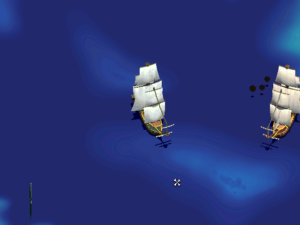
Pirates! veterans will feel right at home with the ship-combat minigame. It was originally more complicated. “When I first started the ship-combat section,” says programmer Chris Purvis, “I had a little readout that told how many cannons you had, when they were ready to fire, and a damage printout for when you or the computer ships got hit. We decided it was too un-adventure-gamey to leave it that way.” Not to be outdone, a member of the testing team proposed implementing multiplayer ship combat as “the greatest Easter egg of all time for any game.” Needless to say, it didn’t happen.
The puzzle design makes for an interesting study. After 1993, the year of Day of the Tentacle and Sam and Max Hit the Road, LucasArts hit a bumpy patch in this department in my opinion. Both Full Throttle and The Dig, their only adventures between those games and this one, are badly flawed efforts when it comes to their puzzles, adhering to the letter but not the spirit of Ron Gilbert’s old “Why Adventure Games Suck” manifesto. And Grim Fandango, the adventure that immediately followed this one, fares if anything even worse in that regard. I’m pleased if somewhat perplexed to be able to say, then, that The Curse of Monkey Island mostly gets its puzzles right.
There are two difficulty levels here, an innovation borrowed from Monkey Island 2. Although the puzzles at the “Mega-Monkey” level are pretty darn convoluted — one sequence involving a restaurant and a pirate’s tooth springs especially to mind as having one more layer of complexity than it really needs to — they are never completely beyond the pale. It might not be a totally crazy idea to play The Curse of Monkey Island twice, once at the easy level and once at the Mega-Monkey level, with a few weeks or months in between your playthroughs. There are very few adventure games for which I would make such a recommendation in our current era of entertainment saturation, but I think it’s a reasonable one in this case. This game is stuffed so full of jokes both overt and subtle that it can be hard to take the whole thing in in just one pass. Your first excursion will give you the lay of the land, so to speak, so you know roughly what you’re trying to accomplish when you tackle the more complicated version.
Regardless of how you approach it, The Curse of Monkey Island is a big, generous adventure game by any standard. I daresay that the part that takes place on Plunder Island alone is just about as long as the entirety of The Secret of Monkey Island. Next comes the Pirates! homage, to serve as a nice change of pace at the perfect time. And then there’s another whole island of almost equal size to the first to explore. After all that comes the bravura climax, where LeChuck makes his inevitable return; in a rather cheeky move, this ending too takes place in an amusement park, with Guybrush once again transformed into a child.
If I was determined to find something to complain about, I might say that the back half of The Curse of the Monkey Island isn’t quite as strong as the front half. Blood Island is implemented a little more sparsely than Plunder Island, and the big climax in particular feels a little rushed and truncated, doubtless the result of a production budget and schedule that just couldn’t be stretched any further if the game was to ship in time for the 1997 Christmas season. Still, these are venial sins; commercial game development is always the art of the possible, usually at the expense of the ideal.
When all is said and done, The Curse of Monkey Island might just be my favorite LucasArts adventure, although it faces some stiff competition from The Secret of Monkey Island and Day of the Tentacle. Any points that it loses to Secret for its lack of originality in the broad strokes, it makes up for in size, in variety, and in sheer gorgeousness.
Although I have no firm sales figures to point to, all indications are that The Curse of Monkey Island was a commercial success in its day, the last LucasArts adventure about which that statement can be made. I would guess from anecdotal evidence that it sold several hundred thousand copies, enough to convince the company to go back to the Monkey Island well one more time in 2000. Alas, the fourth game would be far less successful, both artistically and commercially.
These things alone are enough to give Curse a valedictory quality today. But there’s more: it was also the very last LucasArts game to use the SCUMM engine, as well as the last to rely primarily on pixel art. The world-class cartoon-animation studio that the company’s adventure division had become was wound down after this game’s release, and Larry Ahern and Jonathan Ackley were never given a chance to lead a project such as this one again, despite having acquitted themselves so well here. That was regrettable, but not incomprehensible. Economics weren’t working in the adventure genre’s favor in the late 1990s. A game like The Curse of Monkey Island was more expensive to make per hour of play time it provided than any other kind of game you could imagine; all of this game’s content was bespoke content, every interaction a unique one that had to be written and story-boarded and drawn and painted and animated and voiced from scratch.
The only way that adventure games — at least adventures with AAA production values like this one — could have remained an appealing option for gaming executives would have been if they had sold in truly massive numbers. And this they emphatically were not doing. Yes, The Curse of Monkey Island did reasonably well for itself — but a game like Jedi Knight probably did close to an order of magnitude better, whilst probably costing considerably less to make. The business logic wasn’t overly complicated. The big animation studios which LucasArts liked to see as their peers could get away with it because their potential market was everyone with a television or everyone who could afford to buy a $5 movie ticket; LucasArts, on the other hand, was limited to those people who owned fairly capable, modern home computers, who liked to solve crazily convoluted puzzles, and who were willing and able to drop $40 or $50 for ten hours or so of entertainment. The numbers just didn’t add up.
In a sense, then, the surprise isn’t that LucasArts made no more games like this one, but rather that they allowed this game to be finished at all. Jonathan Ackley recalls his reaction when he saw Half-Life for the first time: “Well… that’s kind of it for adventure games as a mainstream, AAA genre.” More to their credit than otherwise, the executives at LucasArts didn’t summarily abandon the adventure genre, but rather tried their darnedest to find a way to make the economics work, by embracing 3D modelling to reduce production costs and deploying a new interface that would be a more natural fit with the tens of millions of game consoles that were out there, thus broadening their potential customer base enormously. We’ll get to the noble if flawed efforts that resulted from these initiatives in due course.
For today, though, we raise our mugs of grog to The Curse of Monkey Island, the last and perhaps the best go-round for SCUMM. If you haven’t played it yet, by all means, give it a shot. And even if you have, remember what I told you earlier: this is a game that can easily bear replaying. Its wit, sweetness, and beauty remain undiminished more than a quarter of a century after its conception.
The Curse of Monkey Island: The Graphic Novel
(I’ve cheerfully stolen this progression from the old Prima strategy guide to the game…)
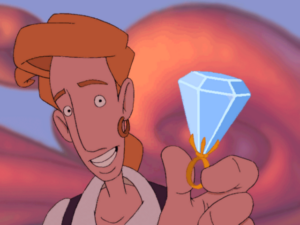
…but manages to escape, sending LeChuck’s ship to the bottom in the process. Thinking LeChuck finally disposed of, Guybrush proposes to Elaine, using a diamond ring he found in the zombie pirate’s treasure hold…
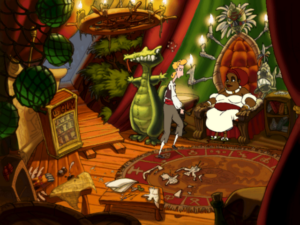
Guybrush sets off to discover a way to break the curse — and to rescue Elaine, since her statue is promptly stolen. His old friend the voodoo lady tells him he will need a ship, a crew, and a map to Blood Island, where he can find a second diamond ring that will reverse the evil magic of the first.
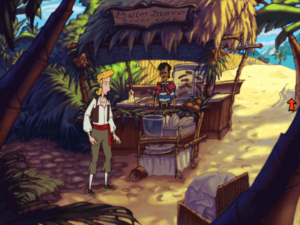
…and a cabana boy, before he is finally able to set sail for Blood Island.
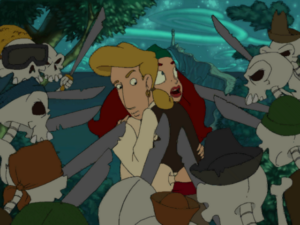
Unfortunately, as soon as Elaine is uncursed, the two are captured by LeChuck and taken to the Carnival of the Damned on Monkey Island.
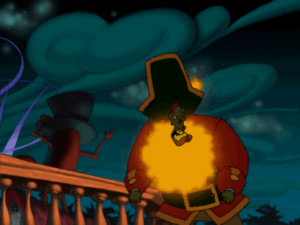
LeChuck turns Guybrush into a little boy and attempts to escape with Elaine on his hellish roller coaster.
Did you enjoy this article? If so, please think about pitching in to help me make many more like it. You can pledge any amount you like.
Sources: The book The Curse of Monkey Island: The Official Strategy Guide by Jo Ashburn. Retro Gamer 70; Computer Games Strategy Plus of August 1997; Computer Gaming World of October 1995, March 1996, September 1997, November 1997, December 1997, and March 1998.
Online sources include a Genesis Temple interview with Larry Ahern, an International House of Mojo interview with Jonathan Ackley and Larry Ahern, the same site’s archive of old Curse of Monkey Island interviews, and a contemporaneous Animation World Network profile of LucasArts.
Also, my heartfelt thanks to Guillermo Crespi and other commenters for pointing out some things about the ending of Monkey Island 2 that I totally overlooked in my research for the first version of this article.
The Curse of Monkey Island is available for digital purchase at GOG.com.
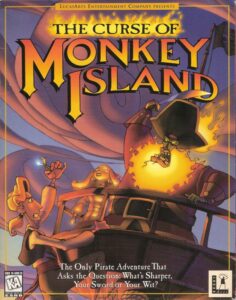
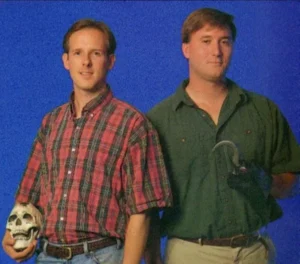
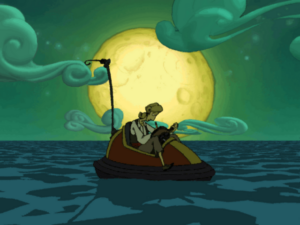
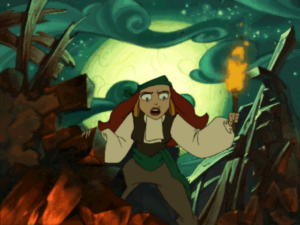
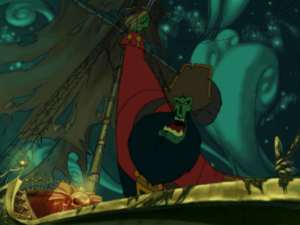
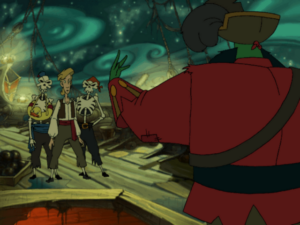
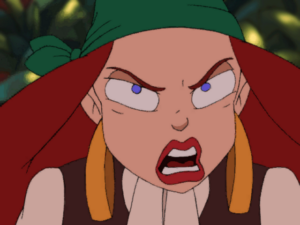
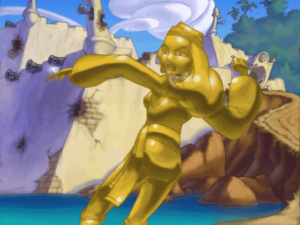
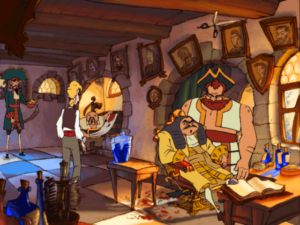
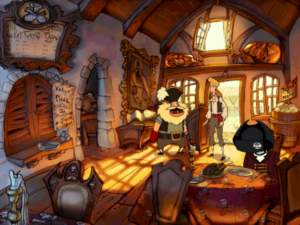
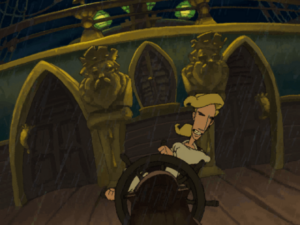
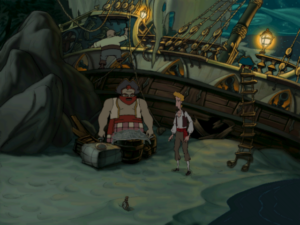
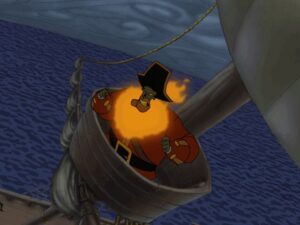
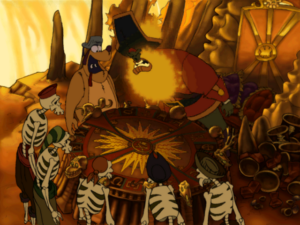
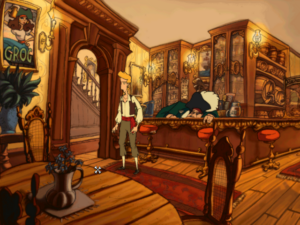
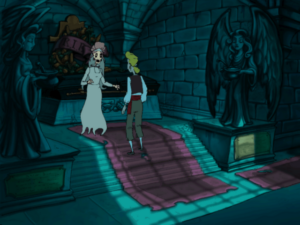
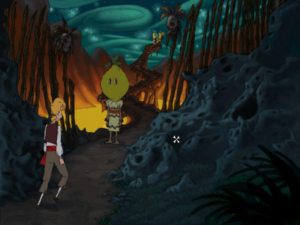
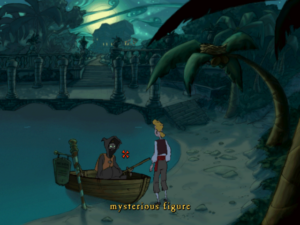
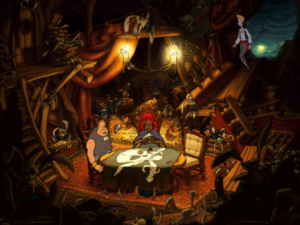
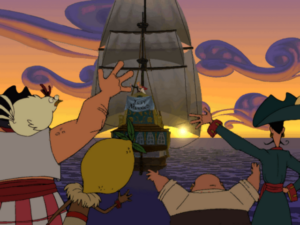












Keith
April 19, 2024 at 5:06 pm
I loved this game so much when it came out. A long-awaited sequel that didn’t disappoint, and this article was a wonderful reminder. Thanks!
> Still, it is a law of the games industry that sequels to hit games will out
Not sure that’s the intended wording.
> Dan Bluth
Don
> Grim Fandango, the adventure that immediately followed this one, fairs if anything even worse
fares
Jimmy Maher
April 19, 2024 at 5:52 pm
Thanks! (The first was as intended…)
Derek
April 19, 2024 at 5:41 pm
First off: The Curse of Monkey Island has the best soundtrack of any adventure game and I will die on this hill.
The end of the game was definitely truncated. There was a whole cutscene at the juncture between Part V and VI that was storyboarded but not animated (explaining how Guybrush ended up on the Rollercoaster of Death, and giving Elaine more to do), as well as another musical number (Google “Plank of Love lyrics”). I recall Chuck Jordan’s blog grumbling about unrealistic crunch-time deadlines at LucasArts, so Even aside from that problem, I find Parts V and VI more frustrating than the Antiquarian does. Part V is where the game feels the need to answer the questions left over from MI2, after dodging them for so long, and while I love the phrase “Carnival of the Damned”, I don’t care for the carnival itself. It feels like most of the exuberant energy of the earlier parts of the game drains away at this point.
But those earlier sections are marvelous. For a lot of the game’s creators, working on a new Monkey Island game was their dream job, and their joy at doing it comes across in their work. They had a knack for taking a funny idea and spinning it out as far as it would go, while keeping it feeling fresh: the proliferating chickens, the ridiculous songs, or my favorite, the Plunder Island Naturalist Society plaques. I don’t think the series ever recaptured this feeling. Later games in the series all have funny moments, but they didn’t make me burst out laughing like the unseen fight in the governor’s mansion in SMI, the Phatt Island Library card catalogue in MI2, or the snake crossing in CMI. (You may claim it’s nostalgia for games I experienced earlier in life, except I encountered the MI games in an extremely unconventional order).
In fact, I’ll court even more controversy and say this is the one point in the Monkey Island series where all LucasArts’ trademark traits are present. SMI has that same exuberant spirit, and unlike any of its sequels, it carries it through from beginning to end. But its technical imitations meant it couldn’t express that sensibility in its artwork the way later LucasArts comedies did. MI2 was the first game to have that cartoon sensibility in its art, but despite some riotously funny gags, its mean streak means it doesn’t have the same overall élan. The early parts of CMI have it all. It lasted only a moment, less than the length of one game, but what a glorious moment it was.
Derek
April 19, 2024 at 5:49 pm
Edit: “I recall Chuck Jordan’s blog grumbling about unrealistic crunch-time deadlines from his time at LucasArts, so I don’t doubt that the Christmas deadline was the reason for the trucation.”
Jason
April 20, 2024 at 11:10 am
“First off: The Curse of Monkey Island has the best soundtrack of any adventure game and I will die on this hill.”
I would have to second that.
LaxJedi
May 18, 2024 at 5:24 pm
Second best. The Dig will always be the best to me.
Marco
April 19, 2024 at 6:11 pm
General agreement from me on everything said so far. I make no secret that I’m not the biggest fan of LucasArts, but this is the game of theirs I like best. It does go odd and abrupt at the end, but the beautiful rendering and design of the early sections more than makes up for it. Special shoutout for two characters: Murray, as Guybrush’s on-again, off-again sidekick; and lemonade chiseller turned gun salesman Kenny (voiced, I now see, by Gary Coleman).
Jack Brounstein
April 19, 2024 at 7:23 pm
Two quick typos:
* “a member of the testing team proposed implementing multiplayer ship combat as an ‘the greatest Easter egg of all time for any game.’ ” has a superfluous “an” immediately before the quote
* “Doh” is more properly spelled “d’oh”—there’s some dispute about this, but that’s the spelling the Simpsons team uses (at least, when they’re not calling the sound just “annoyed grunt”).
Jimmy Maher
April 19, 2024 at 7:46 pm
Thanks!
Alex Smith
April 19, 2024 at 7:31 pm
“ the spirited and fetching lady pirate Elaine”
While Elaine may have a little larceny in her heart, she is not a pirate. She is the governor of the Tri-Island area.
“ (Pirate: “Now I know what filth and stupidity really are!” Guybrush: “I’m glad to hear you attended your family reunion.”)”
That is a Secret of Monkey Island insult. Curse of Monkey Island added the wrinkle that the taunt and comeback must rhyme.
“Annoyed grunt” is spelled “d’oh,” with an apostrophe, not “doh.”
Jimmy Maher
April 19, 2024 at 7:53 pm
Thanks!
Sniffnoy
April 19, 2024 at 9:10 pm
> While Elaine may have a little larceny in her heart, she is not a pirate.
I dunno, she seems to be portrayed as a pirate sometimes… is there really nothing in the games calling her a pirate? I thought there was in the first game, at least.
Alex Smith
April 19, 2024 at 11:23 pm
She is not portrayed as a pirate in the first three games at all. I can’t speak for the later games, but any such portrayal in those would not inform Curse. She is certainly not called a pirate in the first game. In fact, the only reference to Elaine and piracy in Secret of Monkey Island is that she has recently banned pirates from her mansion because of the whole LeChuck incident that turned him into a zombie (he fell in love with her, she told him to drop dead, so he did).
arcanetrivia
April 20, 2024 at 6:06 am
True, she’s not made out to be a pirate at least until the end of Escape from Monkey Island, where she pleads with, uh, someone else (spoilers to say who? do we care about spoilers in a 24-year-old game?) to take over the governorship of Mêlée Island so she can go off adventuring with Guybrush. In Tales of Monkey Island she can be affected by the Pox that, by the game’s own stated narrative rules, only afflicts pirates per se (this is actually made a plot point of, when someone Guybrush thinks might be affected, isn’t), so one might think, she’s become a pirate, or is at least pirate-adjacent. But in any case, up to the beginning of Curse, I wouldn’t call her a pirate.
Guillermo Crespi
April 19, 2024 at 8:26 pm
Hi Jimmy! Here’s a little bit of info you’re probably aware of, but in case it’s useful, here goes:
In all fairness, it wasn’t entirely Ahern and Ackley’s idea to go the “Guybrush has been hexed” route. That path (obscure and undefined as it was) was already set at the end of MI2. If you wait long enough once credits roll over the Amusement Park background you’re shown a small scene with Elaine standing next to the Inky Island hole Guybrush had fell into, and she says:
“I wonder what’s keeping Guybrush? I hope LeChuck hasn’t cast some horrible SPELL over him or anything” (CAPS not mine, they’re in the original game)
I’ve always taken that awkward line as someone’s attempt to leave some sort of trail that would lead them out of that narrative dead-end (like Spock whispering the word “remember” to McCoy’s ear before walking into his death – which wouldn’t last long). I can’t imagine Gilbert being too happy with it (as it seemed to go against the shock and ambiguity of what we had just seen), though I can’t either imagine that line being included without his approval. Maybe someone persuaded him to leave a little something that could help them write themselves out of that corner, should the need arise?
In any case, Ahern and Ackley took that SPELL idea and kinda went along with it in their game.
Jimmy Maher
April 20, 2024 at 7:48 am
That does put a slightly different spin on things. I had no idea it was there. I added a footnote to the article. Thanks!
Jake
April 20, 2024 at 1:27 pm
There’s no evidence the line was added without Gilbert’s awareness. The game was written under very controlled circumstances with all the writer-programmers building the game together in under a year, and Gilbert was still at the studio when the game shipped. The idea that the last line of the game went in without him knowing is very hard to believe.
I was sad to see this article end on a piece of pure conjecture that seemed built more around reinforcing a held opinion about Gilbert, than conveying history or providing context.
When the end of 2 went in, the same team was still planning to make a third game, (at least *eventually,* if not immediately). In recent years, both when doing press for Return to Monkey Island, and before that when doing the livestream with the Video Game History Foundation, Gilbert has been pretty honest and forthcoming about 2’s ending and their lack of specific plans for 3, but they still were planning on making *something.* To me, in that context, the crazy ending of 2 reads more like writers having fun creating a shocking twist that also writes them into a hole that they’ll get to have fun writing themselves out of in the next chapter. It’s something JJ Abrams seems to love to do, to mixed results.
Instead Gilbert and a couple of the other writer/programmers (Tammy Borowick and Bret Barrett), and the game’s producer (Shelly Day) went to make Humongous, leaving Schafer and Grossman behind, who made Day of the Tentacle next instead of Monkey 3, so we’ll never know for sure. But it is documented that—whatever one’s personal feeling about the end to LeChuck’s Revenge might be—the writers were all in on it and aware of what they were doing. For example, they talk about it on the commentary to the Special Edition https://youtube.com/watch?v=US3cTS1Ur6U&t=34m
Thanks for this article, it was a great read! Fan theorizing about the end of Monkey Island 2 is both a fascination and bugbear of mine, so I can’t help myself from writing this up after bumping on that footnote, but I really enjoyed the piece. It made me want to go and replay Curse for the first time in years.
arcanetrivia
April 21, 2024 at 4:01 am
Um, do you have any proof or even circumstantial evidence that this was added without Ron’s knowledge?
arcanetrivia
April 21, 2024 at 4:07 am
Okay, sorry; I misunderstood this actual comment, because Jimmy somehow turned what you said into “It might have been added without Ron’s knowledge”.
fwiw I wouldn’t consider this an “Easter egg” as Jimmy said, either, because you don’t have to do anything weird to trigger the game to show it to you, unlike, say, the “drowned Guybrush” reference you can get if you enter the water in the Welshman’s cove something like 20 times. It’s just a post/inter-credits scene.
Jimmy Maher
April 21, 2024 at 9:38 am
Okay, I tried my lazy best to avoid it, but I’ve done a more substantial rewrite that accounts for what Guillermo pointed out. ;) Thanks!
Busca
April 28, 2024 at 5:30 pm
I thought this whole question about the ending of MI2 had been settled by Ron Gilbert himself in the context of the release of Return to Monkey Island?
“The thing that I’m not sure that people really understand is that this is actually the secret of Monkey Island,” Ron Gilbert tells me. “As I conceived the secret in 1988 when I first started working on the game. This was the actual secret of the game, that Guybrush was just in a giant amusement park. That’s where it got its title.”
Sniffnoy
April 29, 2024 at 5:04 pm
Man, all the later games made a big thing about how we never learned the *real* secret of Monkey Island, but when I played the first game I just assumed that the “secret of Monkey Island” was that there’s a portal to Hell via the giant monkey head. That’s a perfectly good secret! Why can’t we just say that’s the secret of Monkey Island? :P
Ranakabuto
July 7, 2024 at 3:41 pm
Amen! That’s how I figured it at the age of 12 when I first played it.
RandomGamer
September 6, 2024 at 12:17 am
And that’s, ladies and gentlemen, how Gilbert fudged his almost great game of Thimbleweed Park.
Mateus Fedozzi
April 19, 2024 at 8:43 pm
I was going to say you were too kind on the game, but your writing exhales such unusual sweetness this time, making it so very clear this is a game you truly loves to this day, that I am left with nothing really relevant to say besides the fact that the world became a sadder place without a LucasArts around.
Patrick Ingram
April 19, 2024 at 9:18 pm
For a long time, I felt that this game – while very good – was a bit of a disappointment by going back to the two islands setup of the first game instead of the second game’s more open structure. In general, I find LeChuck’s Revenge to be the best of the first three games, though I admit that Maher and I obviously have very different tastes for humor.
This retrospective seems to foreshadow that Maher doesn’t like Grim Fandango. That’s a shame, not that I expected anything different.
arcanetrivia
April 20, 2024 at 6:01 am
For myself (I’m not Jimmy heh) I do like Grim Fandango, but even setting aside its very frustrating linear-access inventory, I was stymied by its puzzles in some places in a way that I wasn’t the first time I played Curse of Monkey Island. As far as “solvability” I think there’s more knocks to be made against GF than against Curse, even in Mega-Monkey mode.
Brent
April 21, 2024 at 12:26 pm
Yep. Grim Fandango’s story and characters are among the best in adventure gaming but many of its puzzles are among the worst. The commentaries in the remake are very enlightening in this regard – Tim Schafer insisted on plowing forward instead of cutting content that was falling behind, resulting in things like the excruciating forest area.
Admittedly the game is already pretty short but there clearly wasn’t enough time for playtesting some of this stuff.
arcanetrivia
April 22, 2024 at 1:34 am
Grim Fandango is short? I remember feeling it was quite long, even that it dragged on more than it needed to. Monkey Island 2’s lite mode is short; Loom is pretty short (both <1.5 hours). Grim Fandango is something like 5-7 hours even when you know what you're doing.
RandomGamer
September 3, 2024 at 3:35 pm
In my personal eyes, I stopped taking what this blog writes about video game difficulty and design too seriously after I saw how differently it treats different games in Monkey Island series and Grim Fandango. The author has a pretty clear idea of what an ideal adventure game should be, and it has to do more with plot setup and atmosphere than with the actual puzzle design and execution.
It seems that the second game’s Guybrush has two sins (which the third game reverses). Firstly, he’s not a nobody trying to be a pirate, but an actual pirate. Secondly, he’s not a loser anymore. Given that the same can be said about equally lukewarm embrace of Full Throttle and Grim Fandango at this blog, where the protagonists have the same traits, I think I see a pattern.
Christian
April 19, 2024 at 9:22 pm
I thought it was 256 colours, not thousands
Jimmy Maher
April 20, 2024 at 7:52 am
Right you are. Thanks!
Andrew McCarthy
April 19, 2024 at 10:15 pm
Great article!
A couple corrections:
“By way of compensation, this latest LucasArts pixel art was to be more luscious than anything that had come out of the studio before, taking advantage of a revamped SCUMM engine that could now display thousands of colors at once at a resolution of 640 X 480. (How strange to think that this technology had been born on a 16-color Commodore 64!)”
Even with CMI, SCUMM still ran in 256 colors. The leap to high color wouldn’t happen until Grim Fandango; this was one of GF lead programmer Bret Mogilefsky’s reasons for designing a new engine, in fact.
“The world-class cartoon-animation studio that the company’s adventure division had become was wound down after this game’s release, and Larry Ahern and Jonathan Ackley were never given a chance to lead a project such as this one again, despite having acquitted themselves so well here.”
As Larry Ahern has mentioned in his video interview with Daniel Albu, they did work on a game idea called Vanishing Act for a while. But it didn’t get very far, and when Jonathan Ackley left the company Ahern decided to switch to working on an abortive Full Throttle sequel instead. (Not to be confused with the other cancelled Full Throttle sequel known as “Hell on Wheels”, lad by Sean Clark, which unlike the first was announced to the public before being cancelled.)
Kaitain
April 20, 2024 at 1:44 am
I’m with you on “LeChuck’s Revenge”. It was a huge disappointment to me, and I agree about the mean-spiritedness of the whole thing. When I played “Monkey Island” I felt like the authors were on my side, and wanted me to have fun. In MI2 I felt that they wanted me to feel like a loser throughout. Lots of irritating puzzles (including that bloody hynotized monkey wrench idiocy), Elaine making the player (as Guybrush) feel like a creepy stalker, and that clever-yet-awful ending.
I liked “Curse” a LOT more. It’s always seemed weird to me that its creators seemed to grasp the spirit of the original game a lot more than the people who actually made the original game did in the sequel.
Ignacio
April 20, 2024 at 4:04 am
Great article, thanks!
Minor typo:
But IT when it’s done this well, who cares?
Jimmy Maher
April 20, 2024 at 7:55 am
Thanks!
stepped pyramids
April 20, 2024 at 4:07 am
Great article, and it really was a lovely game.
It’s “venial” (forgivable) sins, rather than “venal” (susceptible to bribery).
Jimmy Maher
April 20, 2024 at 7:55 am
Thanks!
Alex
April 20, 2024 at 6:17 am
I was a small kid when I played MI2 for the first time. I had to use a walkthrough and ask my brother for help, but I loved it the first time and I loved it time and time again. It has a very special place in my heart. That being said, even as a child the ending got me confused, but I just shrugged my shoulders. However, there is a really nice easteregg when you wait after everyone left the screen. Eventually, a long list of suggestions will pop up telling you what to do after beating the game. Basically, you are told to turn off the screen and do something creative. Along with the nice music playing in the background this always left me with a good feeling and made the ending worthwile.
Now, I remember the big news when MI3 came out many years later. I don´t know when I played it, but I remember that I liked it, but it never moved me in any kind of way that the second one did. And this didn´t change until l today. If I´m being honest, I think that Part 2 is the only one I really connect with. But I´m happy for everyone that saw something in Part 1 or Part 3 that I didn´t :)
Part 4: Yeah, you really could sense that someone tried to emulate the spirit ot the franchise without really understanding it´s essence. I was so disappointed that I quit just about three hours into the game.
Jaina
April 20, 2024 at 2:03 pm
Dude. Glasses.?.! You missed the absolutely called for ‘raise our mugs o grog’.
MI one is my favorite still… Every once in a while I’ll put on the opening music. Two… Had it’s moments but truly didn’t live up to one. And I kinda rushed through three while on a vacation. I still don’t like voice acting, being a speed reader and the voices too slow, but I understand they can add a lot to a story. Well , time to reply 3!
Jimmy Maher
April 20, 2024 at 7:44 pm
Good call. ;) Thanks!
Robert
April 20, 2024 at 8:25 pm
Hmmmm….
As far as I remember, I always interpreted the ending of MI2 as a LeChuck casting a spell on me.
Just before walking off screen, Guybrush’s brother’s eyes glow red and lighting surrounds his head. Obviously there’s some real magic involved and not just imaginary play between brothers.
I always saw it as a setup for a followup game.
Kate
April 21, 2024 at 6:09 am
Thanks for the article.
I think you mean “than” instead of “that” here: “that it really needs to”
Jimmy Maher
April 21, 2024 at 8:30 am
Thanks!
Vince
April 24, 2024 at 5:34 am
My favorite of the series is by far the original, first adventure game I ever played, I remember saving for a long time to be able to afford it AND the 512K RAM expansion needed by an Amiga 500 to run it and still it managed to exceed the high expectations I had.
About later games… I would still put 2 a smidge above 3 purely on nostalgia, I wasn’t bothered by the humor at all as a 12yo, and it was the first substantial game in English language I was able to finish. The second act still stands in my mind as a near-perfect HARD challenge in terms of puzzles (yes, even with the monkey wrench).
But there is no denying MI3 charm, I would go even further in praising the visuals by saying that it is arguably the best looking pixel art SVGA game ever made. In part due to the lack of competition, the fact that the market was between the FMV and 3D craze and the quickly declining fortunes of the genre made sure there were way less games of the same style than there were in the EGA and VGA era.
But the art in itself is amazing, somehow they managed to integrate the zany style of DOTT adding more detail: the wood, fabrics in the environments have texture, which gives the game a really unique look.
The rest of the game is equally high quality, and the voice acting is really the icing on the cake.
Deserved Hall of Fame spot.
salty-horse
April 25, 2024 at 11:03 am
Did the Animation World Network know what they were doing when they compared Guybrush’s nose to Sierra’s logo? :D
Taras
April 26, 2024 at 3:21 am
I’m very fond of this game, but I have some reservations. The biggest one is that Elaine is inexplicably sidelined for this adventure and made into a damsel in distress (a huge step back for the series which subverted that trope in its very first outing) and on top of that has the effect of robbing players of Elaine’s voice for almost the entire game. An interesting character sacrificed for, frankly, a very dull story only there as pretext to explore MI’s version of the Caribbean. I appreciate the difficulty of following up MI2’s ending, but they went for the laziest possible solution to their problem.
Even when we do get some time with Elaine in the cutscenes she’s for some reason head-over-heels for Guybrush, no explanation given except that he’s a man and she’s a woman and they’re in the same game. I’m not even against Elaine and Guybrush, but in MI2 it’s clear that Guybrush’s naive charm has mostly worn off for Elaine, and though she still regards him with some affection their romance is mostly a regrettable episode in her life. I understand that Curse really wants to be a sequel to Secret, not LeChuck’s Revenge, but having no explanation for why on earth Elaine suddenly wants to be with Guybrush was really jarring and unpleasant. If they had had convincing chemistry, maybe then there would be no need for an explanation, but there is none. It just further underscores how little regard Ahern and Ackley had for Elaine as a character.
That last point about chemistry sort of ties into my other major complaint, which is the cutscenes, which are the only points in the game where Elaine is really present. You call Lucasarts a “world-class animation studio” but I see little evidence of that in Curse. The backgrounds are absolutely gorgeous, and the voice acting is mostly excellent (I don’t care for leChuck, but it’s a problem of the actor’s choices rather than his skill), but the animation itself really leaves something to be desired. It comes down to timing, the jokes in the cutscenes just don’t land, and even non-comedic moments are sloppy. I can imagine a version of the chicken and grog gag you describe that works, but the way it comes together in the actual game is awkward and disjointed. The first two games managed much tighter, more effective timing with fewer resources (though Curse acquits itself just fine in this department outside of the cutscenes). Maybe this is evidence of this game’s rushed production and given more time Lucasarts really would have delivered some world-class animation, but that’s not what happened. I would describe it more as “impressive for a 1990’s video game.”
arcanetrivia
April 26, 2024 at 6:27 pm
(I don’t care for leChuck, but it’s a problem of the actor’s choices rather than his skill)
Would you care to elaborate on this?
Taras
April 26, 2024 at 6:54 pm
Sure. It’s just personal preference. Earl Boen is great and he does just the cartoony pirate buffoon voice that Curse calls for, but I miss the more threatening leChuck of MI2 (who, of course, had no voice until the remake, and it was Earl Boen again. I haven’t played that version of the game much so I don’t remember if he captured the different take that game has on leChuck.)
arcanetrivia
April 29, 2024 at 6:25 pm
It sounds to me like what you didn’t like is more the story and scriptwriting choices they made for character, maybe something about the casting director choosing this voice, rather than “the actor’s choices”. He would have been doing what he was directed to do.
Did you ever play the SE of Secret, where he also does the voice, or Escape or Tales? If so, what did you think? (Earl Boen wasn’t cast in Tales at first, but they went back and redid the first chapter with him in it, so now it’s a bit difficult to lay hands on the version that has Adam Harrington instead. There’s videos on Youtube, though, of course.) It’s kind of funny that Earl Boen became so cemented in everyone’s mind as THE voice, like Dominic for Guybrush, that there was considerable disappointment when it came about that he wasn’t going to be in Return (but then, he was ~80 and he died not long after) and some people similarly really don’t like Jess Harnell… because “they missed the more theratening LeChuck of Earl Boen”! Plus ca change, I guess…
Taras
May 3, 2024 at 9:11 pm
You may be right, maybe the fault is with the a casting agent or director, but the point is I’m not a huge fan of the voice, however it came about. I actually really liked Jess Harnell, the way his voice cracks and wavers gives it a lot more character. Earl Boen’s leChuck in Curse is kind of a generic saturday morning cartoon pirate voice, while Jess Harnell’s leChuck is somebody failing to imitate Earl Boen and letting the imperfections themselves become the main attraction. I guess I prefer the latter.
arcanetrivia
May 4, 2024 at 4:04 am
I think Harnell was trying to do something like “recognizable but different” rather than actually attempting to imitate Boen and failing at it; but setting that aside, fair enough!
Hresna
April 28, 2024 at 12:46 pm
This game is my GOAT adventure game. I loved everything about it, the art style, the music, the acting, the story and puzzles, the whole execution. I’ve played it through so many times, its just such a wonderful wholesome experience. I was truly shocked when I learned, later in my life, that Gilbert hadn’t been involved. They absolutely nailed the very best of what the series is about.
The makers of the more modern “Darkestville Castle” adventure game clearly drew very specifically on this instalment of the franchise for their art and music direction. It’s nowhere near as good, but brings a fresh set of puzzles in a monkey-like experience.
Leo Vellés
April 29, 2024 at 2:59 pm
What? Not even a mention of Murray, the mighty demonic talking skull Jimmy? I think his inclusion is one of the high points in this game!
arcanetrivia
April 29, 2024 at 6:03 pm
If you will forgive the expression, Murray’s character has really had legs! He was supposed to be a quick laugh in that opening scene in Curse where you’re fishing things out of the water, but he was so well-liked that they started putting him in other places. And then it must have felt like it wasn’t Monkey Island without him since he got a bit part in Escape and decent-sized ones in Tales and Return. He’s even in the Sea of Thieves expansion The Legend of Monkey Island, which mostly stays very close to Secret in terms of its setting and characters, with a couple of exceptions. (Possibly they just couldn’t resist the Statler-and-Waldorf thing they got going by pairing him with a different talking skull character that already existed in SoT.)
Alex M
May 10, 2024 at 5:32 pm
Lovely read, nostalgia through the roof
Lane Barrow
May 19, 2024 at 8:56 pm
I wanted to come out of hibernation to pay some props to Grim Fandango. I’ve been a huge fan of Lucas Arts for decades now, and the Monkey Island series is a real favorite of mine. I remember being tickled pink when The Longest Journey had a mechanical monkey named Constable Guybrush.
But the characters and story line of Grim Fandango stick in my memory in a way that the MI stories don’t. I even use a rendering of Manny as my avatar at times. I won’t quibble that the puzzles are sub-par, but for me, the story is the prime mover.
Anyway, a big shout-out to you Jimmy! I should have connected with you long ago, so my apologies for the long silence. Glad to see you’re still keeping the faith, my friend.
Jimmy Maher
May 20, 2024 at 7:16 am
Hi, Lane! I hope you’re doing well. A lot of water under the bridge since we last spoke…
Your appraisal of Grim Fandango seems to match mine in the particulars if not the final conclusion: brilliant story, brilliant characters, brilliant setting, brilliant writing… and bad puzzles, bad interface. Unfortunately, I just can’t recommend a game that doesn’t work *as* a game.
Lane Barrow
May 20, 2024 at 11:34 am
Actually, I think we’re in complete agreement. OMG, that interface with tank commands was a nightmare. The remake at least corrected that awful aspect of the game. For me, though, the story made up for the shortcomings.
As for water under the bridge, it’s been, what, 8 years or so? I continue to drop into your blog from time to time to see what you’re up to, and I’ve recommended it to several friends. You still have the most comprehensive and interesting perspectives on the gaming world. Can’t wait to see what you make of VR, though I realize that will be some time yet. Stay well amigo!
P-Tux7
July 16, 2024 at 12:31 am
“Sequels to hit games will out”?
arcanetrivia
July 16, 2024 at 5:47 am
Jimmy said in the first comment that this wording was as intended. I think it’s the same usage as in the phrase “truth will out”, meaning that truth has a way of getting out and becoming public; but I confess I’m not sure what he actually means by it here in this context. Perhaps “hit games have a tendency to produce sequels”?